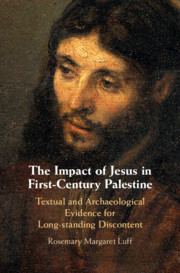 The Impact of Jesus in First-Century Palestine
The Impact of Jesus in First-Century Palestine from Part I - Memories of Jesus: The Textual Evidence
Published online by Cambridge University Press: 26 July 2019
The purpose of this chapter is to utilise a more wide-ranging assessment of textual material, incorporating an approach from oral testimony, in order to understand the Evangelists’ understanding of Jesus’ attitude towards the Temple and its administration. The Gospels of Mark and John attest to the authenticity of the Temple incident, and also confirm that Jesus did speak openly about the destruction of the Temple. They also tally with reference to their Old Testament citations in that Jesus appears to be accusing the Temple authorities of corrupt behaviour. These New Testament texts have originated from oral versions that would have been in circulation much earlier than the written material, and therefore are strongly reminiscent of the words of Jesus. Jesus saw the Temple as a money-spinning enterprise operating at the expense of the poor, the intense commercialization obliterating any sense of a ‘house of prayer’. He viewed the rich landowners of the priesthood as a major cause of misery for the poor. Indeed his brother James carried on his ministry to the impoverished, and was remembered as vehemently denouncing the avarice and venality of the rich.
To save this book to your Kindle, first ensure [email protected] is added to your Approved Personal Document E-mail List under your Personal Document Settings on the Manage Your Content and Devices page of your Amazon account. Then enter the ‘name’ part of your Kindle email address below. Find out more about saving to your Kindle.
Note you can select to save to either the @free.kindle.com or @kindle.com variations. ‘@free.kindle.com’ emails are free but can only be saved to your device when it is connected to wi-fi. ‘@kindle.com’ emails can be delivered even when you are not connected to wi-fi, but note that service fees apply.
Find out more about the Kindle Personal Document Service.
To save content items to your account, please confirm that you agree to abide by our usage policies. If this is the first time you use this feature, you will be asked to authorise Cambridge Core to connect with your account. Find out more about saving content to Dropbox.
To save content items to your account, please confirm that you agree to abide by our usage policies. If this is the first time you use this feature, you will be asked to authorise Cambridge Core to connect with your account. Find out more about saving content to Google Drive.